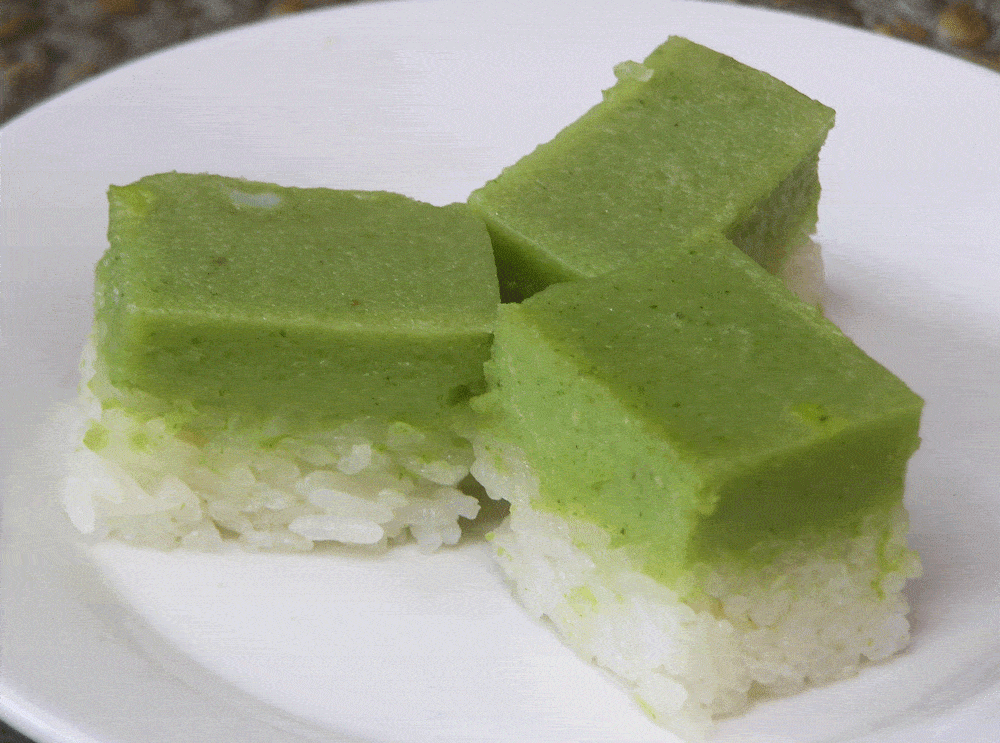This is a great guest post from KP Kwan. He enthusiastically shared this recipe of Seri Muka, a dessert of the local Chinese with Malay influence. You can read his full bio at the end of the article.
Seri Muka is like many other desserts from the Nyonya cuisine, which is a unique blend of Malay and Chinese culinary culture. The word “kuih” means sweet dessert in Malay. Seri Muka ( also known as Seri Muka and Kuih Seri Muka) is a traditional Malaysian / Peranakan dessert (kuih in Malay) that consists of two layers – one is savory and the other one is sweetened.
Traditional kuih (dessert) is very much popular in most of the Malays families. Seri Muka has become the favorite dessert for people from all religion and races in this multiracial country. It is most popular, especially among the Malays and is served during the festive season such as during the Ramadan month for ‘buka puasa’. It is also a popular dessert for breakfast and afternoon tea as well as special occasions, for example, during wedding reception and festival season.
Seri muka literally means ‘shining face’ in Malay. The dessert has the steamed glutinous rice forming the bottom layer, which is savory. The upper layer is a custard made with pandan (screwpine leaves), egg and coconut milk. Coconut milk which is called santan in Malay, imparts the creamy and tropical flavor into both the rice and custard layers. If you are concerned about the green coloring of the upper layer, let me assure you that is due to the use of pandan or screwpine leaves, making it perfectly natural.
Most of the Seri Muka you purchase from the shop or store might have used green coloring to enhance the appearance of the kuih. However, the color of the top layer of this recipe is the result of the juice the pandan leaves which is green. I blend the leaves together with other ingredients to extract as much flavor and color as possible.
As for the coconut milk, it is a little indulgence every now and then, right? It is best to use the freshly extracted coconut milk, which I can get it easily in any market in Malaysia. If you are in other countries where there is a difficulty to get fresh coconut milk, packet or canned coconut milk is the next-best thing you can use, I did try it once and it is perfectly acceptable.
Recipe
Ingredients
- Bottom Layer
300g of glutinous rice
150g of coconut milk
10g (1 teaspoons) of salt
5g (1 teaspoon) of sugar - Upper Layer
4 medium size eggs
55g cornflour
70g cake flour
200 g sugar
6 pieces of pandan leaves
2.5g (half teaspoon) of salt
600g of coconut milk
Instruction
Bottom Layer
Wash the glutinous rice and soak it in water for 4 hours, drained.
Add the coconut milk, salt, and sugar and mixed well.
Transfer the rice to a metal container and steam for 5 minutes
Fluff the rice and steam for another 30 minutes.
Use a metal fork to press the rice so that it forms a solid layer.
Upper Layer
In a separate bowl, blend the corn flour, wheat flour, sugar, pandan leaves, salt and coconut milk.
Filter the mixture to remove any impurities and the leaves.
Add the eggs into the filtered mixture and mix well.
Heat up the mixture over low heat until it starts to thicken.
Pour the hot mixture onto the pressed glutinous rice layer.
Scoop off any bubbles on the surface of the mixture.
Steam again for another 15 minutes over very low flame until the top layer is set.
Tips to make a perfect Seri Muka
1. It is important to use glutinous rice only in this recipe. It should be soaked for at least four hours or even overnight before steaming. Otherwise, it is difficult to cook through even if it is steamed for a longer period.
2. It is best to use freshly pressed coconut milk from the market. It is thick and creamy. However, if you are not able to get the fresh coconut milk, you can substitute it with coconut milking can or box. It is crucial to use sufficient coconut milk since it is the major ingredient for this recipe. Do not add water to make up the volume.
3. Fluff the rice after steaming for five minutes and steam for another 30 minutes. Fluffing helps to loosen the rice so that it is easier to cook by steaming. After 30 minutes of steaming, open the lid of the steamer and check whether the rice is soft enough. You can steam for a longer time if it is not soft enough. The timing depends on how long the rice was soaked, how much water is in the steamer, and the amount of heat to steam it.
4. It is preferable to cut the pandan leaves into small pieces and blend with other ingredients for about 3 – 5 minutes. Filter the mixture through a sieve to remove the leaves. The mixture has now become a homogenous liquid, which is slightly greenish due to the pandan extracts. Beat the egg and add into the green mixture.
5. You can pour the green mixture directly onto the rice layer. However, it is better to cook the mixture first over low heat until it is partially cooked and slightly thicken. This is useful to ensure the innermost part of the custard is fully cooked when the surface of the custard is set.
6. Always steam Seri Muka cover with a lid over very low heat. The surface will become uneven and if high heat is used.
7. Let the Seri Muka cool down completely before removing it from the mould. Traditionally, Seri Muka is served by cutting into a diamond shape of about 3 cm width.
——————-
Bio
KP Kwan is from Kuala Lumpur, Malaysia. He is a pharmacist turned restaurateur and an avid food blogger. He can be reached at www.tasteasianfood.com.


